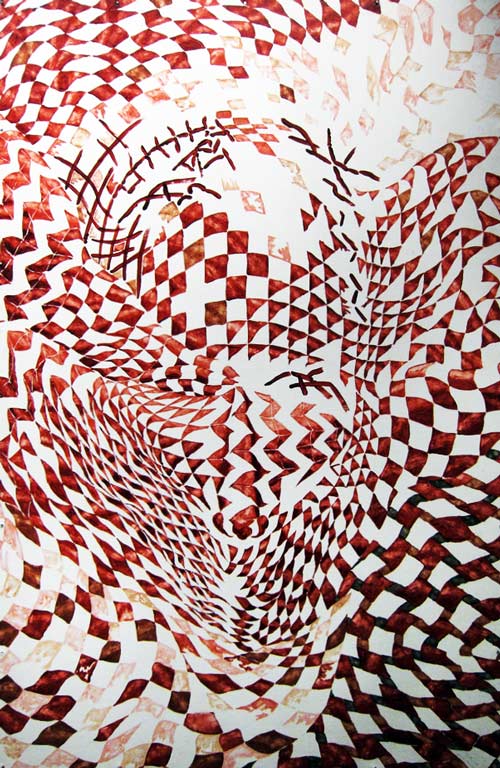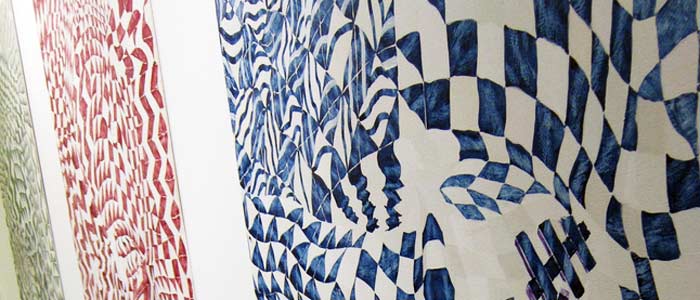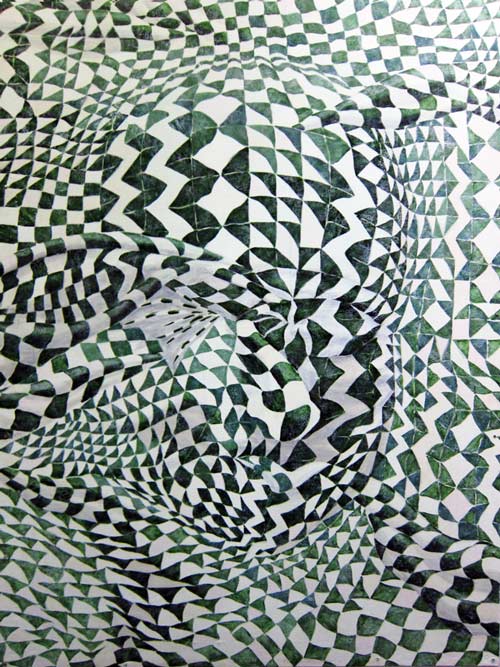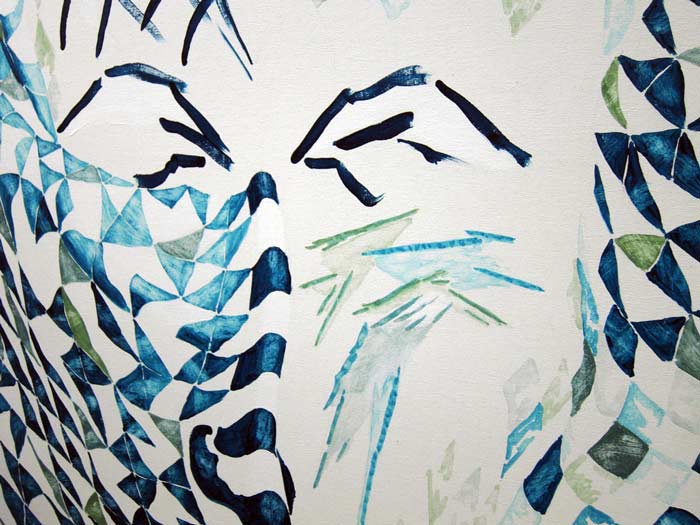Marvin Gaye’s “Got to Give It Up,” a cover of Sade’s “Sweetest Taboo” – the music playing is unexpected to say the least. I was imagining something more along the lines of Steve Reich or Adagio for Strings on repeat or just silence. I smile and try to shake off the heaviness and dread I managed to bring with me in preparation for something as potentially dark as a memorial service. But this is not what I’m attending. Instead, I’m snapping photos and jotting down notes at Gallery 175 at the reception for Susan Michod’s 9/11 Shroud Series, showing until September 29th. Urban adult contemporary along with clusters of folks embracing each other and laughing—their chatter stirring in me the many memories I have of family get-togethers. This show is not what I expected in many ways.
The gallery is small but completely ample for the six pieces in the collection. I charge forward to one of the pieces at the back of the room. Immediately, hesitation snuffs out my momentum as I realize I’m probably — if there is such a thing — starting out of order; I should back up and start at the one closest to the entrance. Impulse control slips away. Something in this piece compels me.

Standing and staring now, a confluence of two thoughts clash in my head: All the paintings look very similar with a patchwork quilt of patterns and the eerie valleys and peaks suggesting a face in the center. But the color of this one is the closest to blood—forms seeming to move like blood-soaked flags in the wind. I can feel my cheeks flush. People laugh behind me. I smile and shrug off my darker thoughts. But it’s there — the darkness. I’m even noticing that as the shapes slip into other shapes, they eventually terminate into strands resembling chromosomal stains. The painting almost heaves. But for mascara, I’d be rubbing my eyes.
The description of the piece entitled, “Winter Shroud,” created in April of 2002, mentions the Winter Garden that functioned as a conservatory for the Twin Towers. Palm trees and a performance space are mentioned. I keep staring and try desperately to see the palms and the winter and the garden. I move on.
“Collapsed Shroud,” completed January, 2002, is next. I get goose bumps as I immediately think of this piece as the shadowy side of the first; now all the blood is drained, and what’s left are the ashen grays. Blood and ash. I now realize the past-tenseness of the descriptions—“There was…which had….” The Lakota point to a location when dealing with time. “When was Wounded Knee?” you ask. They point and say, “Over there.” I reckon the two Twin Towers now with “There was” and “which had” and see before me the disemboweled and perforated grids hanging, these canvases that, if you look long enough, you struggle to gain a more secure footing even on perfectly stable ground.
I reread the description again and come across “Gothic arch…all patterns are based.” I think of this month’s Atlantic where I just read on Antoni Gaudí and how he felt about Gothic cathedrals being inadequate because they needed so much help to keep aloft with an interior’s worth of scaffolding; Gaudí’s style needed no help. “If a Gothic cathedral is…a sermon in stone, then [Gaudí’s] work is a sermon in broccoli.” I look back at the image entitled, “Collapsed Shroud” and think of it in terms of sermons in stone and broccoli and then two long spires falling and collapsing to the ground. I move on.

A wall of color spans across three canvases. “Broken Shroud,” completed in mid-November 2001, is blue and white. My internal meaning-making shifts from bloodied flags to billowy sails on a ship on a rippling ocean. A steady breeze interrupted by puffs of air clear away the non-existent ash and fumes so carefully evoked from the previous pieces. I notice again the date. Mid-November, 2001. Not much time to process the events. This piece must be the most raw. The description confirms – perhaps – my suspicion: “The Trade Towers broke apart…in sections of three, so all the patterns are based on threes.” I try to make sense of “3” in every which way: triplet, sequence, trinity, and so on. But so much of this piece is just as much about a disorder no amount of counting can contain. And yet here it is. In 3s.
“Crumpled Shroud” is also red but – as I wrote down in my little notebook – “It’s brimming with violet hues. I think of old blood, drying. Flowers. I see Stars of David in the patterns.” I muse to myself of the present-ness of the description: “The image in this cheekbone is…swirling…are multi-hued—.” This piece was created in October of 2001. Barely a month of time had passed since the Towers had fallen. I step back again and stare.

And now it comes full-circle, I think to myself. “Fractured Shroud” was created mid-August, 2001, a month before 9/11. And yet, it’s so similiar! Or is it. It’s full of greens, of chlorophyll, of life. And then I pause for this might be the darkest of all the pieces because Susan mentions death and guilt and beauty and pre-9/11. I look again and slowly begin to notice the subtle shadows between the green, amidst the whites, pressing hard toward the center against the finger-like clasp of something that once might have been less constrained. There’s something sinister in the tall grass of this “Fractured Shroud.” I stare into the face-ness of it, the before-ness of it. I pivot to leave and notice there’s one more on the wall behind me. I pause and a man asks me what I think.
I explain I am writing a story on this, and so I’m thinking quite a lot. Then I make a joke about the music. He quickly admits that it was he who chose the music, if you can call choosing “pressing play” on the CD player. I laugh. Of course! Then I marvel at how easy some mysteries are expelled.
He keeps on and tells me that it’s his birthday today and how one of his friends died in the first plane and how he found out just today that this friend was supposed to take a later flight but changed times and how he and his friend are Buddhist and did therapeutic work with men in the same age group as the hijackers. I’m overwhelmed. We both laugh at the incredulity of his situation. And then he leaves to meet his family for a birthday dinner.
Perhaps that is why when I finally look at the last painting, I’m so uncomfortable. Called “Summer Shroud,” it was created in May-June of 2002. It starts out: “Of course it was glass.” There’s wit here, I think. This piece has the most negative space, large swaths of blank canvas. It’s affecting in me a restlessness. Maybe I’ve looked too much, thought too much. Or perhaps this one is—ah. I see it. She’s actually gone literal and shards of glass on the cheek of the shrouded face are held in suspension. Falling, cutting, for as long as you can stand it, can stand to stare.

I leave the exhibit with my brain on fire. My cup is full. I need to get outside and walk around. And then I need to return…